By Kate Phizackerley. Published in Egyptological Magazine, Articles on August 14th 2012
The Pyramids of Zawiyet el-Aryan
Together with the mask of King Tutankhamun, the Sphinx and pyramids are probably the most readily recognised of ancient images, with countless images published of the Giza pyramids. Rock cut tombs were designed to be covert, but pyramids were always intended as visible symbols of a king’s reign and his royal (godly?) legacy. Just as some English castles are now little more the traces of wall lines and mounds of rubble, it is unsurprising that several much older Egyptian pyramids have likewise slipped into similar preservational ignominy; others were unfinished. Again, as with castle keeps, most (all?) of the major pyramids were simply the most visible focus of a larger complex or enclosure often comprising temples and either satellite pyramids or mastabas. One might naively assume that all such visible structures would have been comprehensively excavated and studied. Not so. A good example is the case of the two pyramids at Zawiyet el-Aryan. A map of the site, showing its position relative to Giza, is available online on the Pyramids of Egypt site at http://egyptphoto.ncf.ca/Zawiyet%20el-aryan.htm.
Pyramids of the Third Dynasty
Many Egyptian histories give the impression that pyramid building was inaugurated in the Third Dynasty by King Djoser and his architect Imhotep with the Step Pyramid at Saqqara; Sneferu and an unknown architect pioneered the construction of “true”, smooth-sided pyramids at the start of the Fourth Dynasty; and pyramid building segued quickly and mysteriously into the massive and complex edifice of Khufu’s Great Pyramid at Giza. This sense of false mystery is one John Romer wished to dispel in his [A] History of Ancient Egypt – From the First Farmers to the Great Pyramid, although again he makes scant mention of one of the pyramids at Zawiyet el-Aryan and ignores the other – although it may fall outside the timeframe which is the focus of his book.
In fact at least two other Third Dynasty kings attempted to build step pyramids, one of which would probably have topped Djoser’s in height had it been completed. A further unexcavated enclosure at Saqqara, west of the Sekhemket enclosure, may also be a Third Dynasty pyramid enclosure (Siliotti, p129). There are also a further seven known small, step pyramids dispersed provincially across Egypt. Relatively little is known about them but most authors date them tentatively to the end of the Third Dynasty. There is much more to Third Dynasty pyramid building than Djoser and Imhotep.
The Layer Pyramid at Zawiyet el-Aryan
One of these relatively unknown Third Dynasty pyramids is the northern Pyramid at Zawiyet el-Aryan. Generally known as the “Layer Pyramid”, it has been excavated on three occaisons: Gaston Maspero was the first Egyptologist to excavate the pyramid in 1881; Alessandro Barsanto followed in 1900; and finally the pyramid was re-excavated George Andrew Reisner and Clarence Fisher in 1910-11 (Dodson, The Pyramids of Ancient Egypt, p47). The excavations proceeded quite differently. Maspero cut a deep notch into the heart of the superstructure, although Dodson hedges his bets as to whether Maspero was responsible for the terrible scarring of the pyramid stating blandly, “The cavity in the north face was created by early hunters seeking the entrance to the burial chamber.” (Dodson, The Pyramids of Ancient Egypt, p46). It is believed that Maspero never penetrated into the passages beneath the pyramid that comprise the substructure, so it appears that Bursanto was the first to reach the storage magazines and burial chamber. Although Reisner and Fisher also ventured into the tunnels, they concentrated on some of the tombs and mastabas surrounding the pyramid (Dodson, The Pyramids of Ancient Egypt, p.47).
The Layer Pyramid was never completed but takes the form of an unfinished step pyramid. Beyond such superficial facts, texts diverge. Although Zawiyet el-Aryan lies between Giza and Saqqara it is difficult to visit because of the proximity of a military zone and access is largely prohibited. In troubled times this may be welcome protection from looters, but Michel Valloggia warns that the site is at risk from urbanisation around the southwest extension of the Cairo Ring Road (Hawass et al, p.231). The access difficulties may have contributed to the discrepancies in the published modern height of the remains of the pyramid with Siliotti stating 16m (p.93) and Ali Radwan claiming 18m (Hawass et al, p.110). Ghoneim (p.24) offers 60 feet and the indications are that he visited the site in 1954 when the Southern Pyramid at Zawiyet el Aran was filmed, although it is doubtful he did more than visually estimate the height. 18m/60’ nonetheless seems the more reliable measure. Such discrepancies are magnified when one attempts to discover the dimensions of the internal passageways. Dodson addresses this (Dodson, The Layer Pyramid of Zawiyet el-Aryan: Its Layout and Context, p.81, figure references removed for clarity):
In their seminal work on the pyramids, Vito Maragioglio and Celeste Rinaldi point out the curious fact that the two excavators of the Layer Pyramid … drew sections of the substructure that differ not only in detail, but in fundamental dimensions and also in the very number of galleries! Furthermore, the dimensions derived from the scale drawings (or, rather, sketches) in some cases differ from the figures mentioned in the respective excavators’ texts
Dodson highlights several fundamental differences. For example, Barsanti indicates that the entrance shaft descends some 8.5m below the lowest intersecting transverse passageway (the depth is interpreted because it not directly stated by Barsanti), but Reisner and Fisher show its bottom level with the floor of this passageway. Dodson attributes this (The Layer Pyramid of Zawiyet el-Aryan: Its Layout and Context, p84) to a failure by the Americans to fully clear accumulated debris during their investigation, and indeed speculates as to whether the pair even measured the burial chamber itself, or whether they simply re-stated Barsanti’s measurements for this chamber. Oddly, the the two expeditions’ reports do agree precisely on the dimensions of the burial chamber, suggesting perhaps that the Americans relied upon Barsanti’s measurements of this chamber. Less explicable is why Reisner and Fisher omitted an entire second transverse corridor from their schematics. There are further significant differences between the two reports in terms of measured dimensions.
Because Reisner is a highly respected Egyptologist, many later books and websites unfortunately use his plan as the authoritative version. For example, Siliotti (p93) clearly replicates the Reisner and Fisher layout, as does Lehner (p.95). Which survey is correct? Dodson has photographic evidence (The Layer Pyramid of Zawiyet el-Aryan: Its Layout and Context, p.84) clearly showing a corridor in the wall above the staircase well, the corridor shown on the Barsanto plans but omitted on the Reisner plans and later derivatives (see Figure **). Less clear is which survey’s measurements are the more accurate.
The one volume on my bookshelf that shows the correct schematic for passages is Dodson’s book The Pyramids of Egypt, which I bought while researching this article. Likewise, this is the only reference I consulted that mentions Maspero’s excavations of 1881. Indeed, Siliotti, whose books I generally admire, goes so far as to state, incorrectly, that “The monument [was] discovered by the Italian Egyptologist Alessandro Barsanti in 1900.” Were this indeed the case then presumably he would also consider Barsanti responsible for the effective removal of the north face of the pyramid?
Despite the discrepancies identified by Dodson including in lengths of corridors, all schematics that I have seen show the burial chamber situated directly beneath the apex of the pyramid. While this was the builders’ presumed intention, none of the sets of published measurements is sufficient to validate whether their intention was realised.
The Substructure of the Layer Pyramid
While the dimensions of the substructure remain uncertain, their configuration is known. The U shaped tunnel beneath the west, north and east sidesgive access to 32 storage magazines (closets). It seems likely, as Dodson proposes, that the original intention was to excavate a burial chamber at a similar depth but this was abandoned. Instead a shaft was driven and a passage cut at a lower level, which was again abandoned. The “burial chamber” was eventually created with its ceiling over 60 feet below ground level. Dodson reasons, probably accurately, that the rock proved unstable in the upper levels necessitating the deeper tunnels. Certainly there has been roof fall over the years and the tunnels were full of debris.
The greater depth also probably required a reconstruction of the intended access arrangements for the magazines. Instead of a typical tunnel and ramp rising to debouch north of the pyramid, a right-angle was included so that the higher levels of the access face east. This unique arrangement may be one reason why the pyramid was not penetrated by earlier explorers. Dodson suggests that the purpose was to provide easier access to the magazines, but this seems somewhat unclear. Dodson also observes in The Pyramids of Ancient Egypt (p.46) that stone blocks have been seen on the surface which might be consistent with a causeway heading east to a valley temple. Again these blocks have not been formally surveyed or excavated. An alternative explanation is that other monuments already occupied ground due north of the pyramid. Although there has been some excavation of the enclosure, it is unclear whether the northern zone has been excavated sufficiently to test this alternative theory.
Although missing one of the passageways, a diagram on page 95 of Lehner’s book helps to portray the substructure and should be consulted.
Perhaps the biggest mystery is that the pyramid was probably neither finished nor used. Had the superstructure been completed it is estimated that it would have risen in five steps to a height of between 140 and 150 feet. It is not just the “burial chamber” that was empty (as seems common with Third Dynasty pyramids); the storage magazines also showed no signs of use.
Ownership
The layout of the substructure is seen by many commentators as evidence that the pyramid was built immediately after the Buried Pyramid (attributed to Sekhemket), which has a similar U-shaped tunnel accessing magazines, although that pyramid’s magazines are cut on both sides of the access tunnel, whereas in the Layer Pyramid’s all the magazines face towards the interior of the pyramid. The Buried Pyramid also has substantially more magazines. Dodson, for example, states “The design of the substructure shows it to be almost certainly the direct successor of Sekhemket’s monument.” (Dodson, The Pyramids of Ancient Egypt, p.46) For me this certitude seems misplaced. The sequence of Third Dynasty kings remains a matter of debate. As we shall see later, when we examine the Southern Pyramid, it is also possible that further Pyramids were begun in the Third Dynasty but building ceased before a visible superstructure was started. Sarah Parcak claims to have identified 17 unknown pyramids by using satellite imagery, including two at Saqqara (BBC News video 2011, and Byrnes).
It is also known that as the Egyptians became more proficient in pyramid building during the Third Dynasty larger blocks were used to build the superstructure with the optimal size apparently being a block which could just be carried by two men. Larger blocks mean that fewer of them are needed, and probably create a more stable pyramid. Unfortunately the texts available to me fail to indicate the size of blocks used to build the Layer Pyramid. It was, however, built in an otherwise identical way to the two other identified Third Dynasty pyramids, the Step Pyramid and the Buried Pyramid, with courses of stone laid on a slant.
Typographically the pyramid clearly belongs with the other step pyramids. Most commentators believe it to be the last of the known Third Dynasty step pyramids and, as we have seen, to be belong to King Djoser Sekhemket’s successor. Personally I think its place in the sequence of pyramids remains unproven. I am not suggesting it should be placed elsewhere in the sequence, but I do believe we should keep an open mind and recognise that further study is required before the sequence is accepted.
The problems multiply if we attempt to attach a name to the king who built the pyramid. Reisner and Fisher concentrated their attention on some of the tombs in the pyramid’s environs. They found eight bowls in the mastaba/tomb designated Z500, which bear the Horus name Kaba. On this basis most commentators identify the Layer Pyramid as Kaba’s pyramid. Even Dodson in his Pyramids of Ancient Egypt heads the entry “Kaba’s Pyramid”. Lehner is among those who have suggested that Z500 might be Horus Kaba’s tomb.
In his later paper for the ARCE Journal, Dodson’s position has evolved and he weighs the evidence for attribution more carefully. For example he records an objection to the dating of the Kaba bowls:
However, in 1983, Swelim questioned this, arguing that the Horus Khaba bowls were typologically earlier than those from the Horus Sekhemkhet pyramid and from Beit Khallaf K2, dated to the reign of the Horus Sanakhte, and thus too early to be associated with the pyramid
I have not had access to Swelim’s work, but Dodson indicates that Swelim also rejects the identification of Horus Sekheket (the commonly presumed builder of the Third Dynasty Buried pyramid) as Djoser’s successor Djoser Ty (Horus Netjerykhet), preferring to see nine kings in the Third Dynasty as recorded by Manetho. However, Dodson in his paper for the ARCE journal recognises that the identification of Kaba as the builder of the Layer Pyramid is problematic in terms of the succession of kings. So, while many identify the pyramid with Horus Kaba, the more honest position would be that we don’t really know. Further research and excavation are needed to resolve the sequence of the Third Dynasty kings and their association with the funerary monuments they left behind.
The Unfinished Pyramid of Zawiyet el-Aryan
If there are questions surrounding the northern, Layer Pyramid, the Southern Pyramid (or Unfinished Pyramid) at Zawiyet el-Aryan is a mystery. It is a pyramid only in presumed intent because no superstructure was constructed. Within “alternative” Egyptology, some question whether a pyramid superstructure was even planned.
All we have is a massive trench with an area cleared for a burial chamber. This included a granite tub sarcophagus, which was found empty when the trench was cleared. Had the pyramid been constructed it would have been similar in scale to the famous Giza pyramids and most commentators date the monument confidently to the Fourth Dynasty with Dodson saying “The measurements alone compel us to date this unfinished scheme to the 4th dynasty.” (Dodson, The Pyramids of Ancient Egypt,p.138) Hieratic inscriptions on the walls have been translated as Nebka or Whemka or even Baka. Some see this as a short-lived ruler who reigned between Khafre and Menkaure; a minority ignores these inscriptions and associates the pyramid with Horus Kaba on the basis of the bowls found in the Z500 mastaba, thereby suggesting that the pyramid might be a Third Dynasty monument. During my research I have seen no consideration that the Northern Pyramid might have been built by a king whose pyramid is already known, as with
Senefru, who built the Bent and Red Pyramids at Dashur as well as the Meidum Pyramid. If this were the case, ithis would mean that the difficult Nebka inscriptions could represent a secondary name for a king we know principally by another name. Whilst this scenario is less likely than that of an unknown king who died young and was unable to finish his pyramid, it seems difficult to discount the possibility entirely.
The French Wikipedia entry for “la grande excavation” states that when the area was excavated by Alessandro Barsanto he found a plaque nearby which the name of King Djedefre. This discovery is unmentioned in the English texts I have studied and I have not yet traced the reference. The French Wikipedia entry also records (translation by Andrea Byrnes and Kate Phizackerley):
The excavations continued in 1904 and allowed Allesandro Barsanto reaching the bottom of the pit in 1905. He discovered a pavement made of huge stones of granite and limestone cut and adjusted with great care, and the oval sarcophagus. An exceptional weather event had resulted in flooding of the pit to a height of three meters.[ Barsanto] noted that the water level suddenly dropped a meter, equivalent to 180 cubic meters, which was germinating in his mind the idea of an underground chamber. He then undertook the work of dismantling the Pharaonic floor of the pit by moving the huge stones of the pavement one by one. Meanwhile, he dug tunnels in the walls in order to circumvent the foundations more rapidly. A riot of resources and effort enabled him to move many blocks. The project was interrupted in 1907, to resume much later in 1911 . Barsanti then centred hisresearch around a particularly large blockweighing nearly four tons, which seemed to be a barrier to access of the hypothetical burial chamber. Lack of funds halted the excavations again in 1912 and were never resumed, as premature death that hit the French Egyptologist.
The pyramid’s substructure was last exposed in the 1950s to provide the setting for a movie set for Land of the Pharaohs. There is a brief glimpse in the trailer. It is clear that a more thorough excavation of the trench and surrounding area is needed to attempt to resolve the many remaining questions. It would also be interesting to trace (and translate) the original excavation reports to see whether the French Wikipedia entry is accurate. If it is, then this monument is much more interesting that the paragraph or so it usually receives in most English texts.
Conclusion
This article came about after I started work on an article about the Buried Pyramid at Saqqara, a project that I will hopefully complete for the next edition of Egyptological Magazine. When I referenced the little known Layer Pyramid at Zawiyet el-Aran I decided to provide a short contextual piece on the pyramids as a helpful background for readers. It grew into this much longer article.
I am accustomed to assumptions and omissions in material written about the Amarna period. Naively I had assumed that such problems were unique to that chaotic period. In writing this article, it has become clear that there are errors and possibly major omissions in many of the common texts on pyramids when it comes to the two pyramids at Zawiyet el-Aran. If I can trace the excavation reports for la grande excavation then there is clearly more for me to study in relation to the obscure Unfinished Pyramid. It is a topic to which I would like to return in a future article.
I have chosen to abstain from identifying the builder of either pyramid in this conclusion. I need to study the Third Dynasty in much greater detail, but my impression is that based on present archaeological knowledge in both cases any identification of the kingly patron could only be tentative and probably premature. It would be good to see further excavation at this site but, with its location within a military restricted zone, I am reconciled to that being likely during my lifetime.
Bibliography
Byrnes, Andrea
Television Review: Egypt’s Lost Cities
Egyptological In Brief, 20th June 2011
/2011/06/television-review-egypts-lost-cities-4325
Dodson, Aidan
The Layer Pyramid of Zawiyet el-Aryan: Its Layout and Context
Journal of the American Research Center in Egypt, Vol. 37 (2000), pp. 81-90
http://www.jstor.org/stable/40000524
Dodson, Aidan
The Pyramids of Ancient Egypt
New Holland
London?, 2003
Ghoneim, M. Zakkaria
The Buried Pyramid
Longmans, Green and Co
London, 1956
Hawass, Zahi et al.
The Treasures of the Pyramids
The American University in Cairo
Lehner, Mark
The Complete Pyramids
Thames and Hudson
London, 1997, reprinted 2001
Romer, John
A History of Ancient Egypt – From the First Farmers to the Great Pyramid
Allen Lane
London 2012
Siliotti, Alberto
The Pyramids
Weidenfeld and Nicholson
Italy 1997
Image Credits
Burial-Chamber? Southern-Pyramid-Zawiyet-el-Aryan circa 1912, copyright expired
Dolomite bowl bearing the name of King Khaba, inscribed within a serekh by Keith Schengili-Roberts, via Creative Commons.
Incorrect schematic of Layer Pyramid by Malyszkz based on Reisner, via Creative Commons
Photograph of Layer Pyramid by Pottery Fan, via Creative Commons
Plan of the Substructure of the Layer Pyramid by GDK, via Creative Commons
Plan of Zawiyet el-Aryan by Kate Phizackerley based on Lepsius
Southern Pyramid, Zawiyet el-Aryan – Burial Chamber Detail, believed copyright
Southern Pyramid, Zawiyet el-Aryan – Burial Chamber Detail, believed copyright expired
Trench in Southern Pyramid, Zawiyet el-Aran, believed copyright expired
Video Credits
Land of the Pharaohs, Trailer, 1955 via YouTube at http://www.youtube.com/watch?v=PFPIQgz2e-g
BBC News, World News 2011 item, Via YouTube at http://www.youtube.com/watch?v=NJoYaKDn4Cg
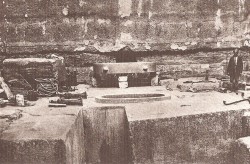
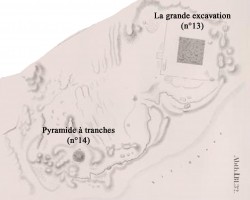
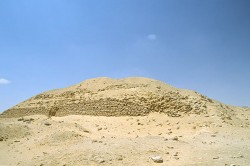
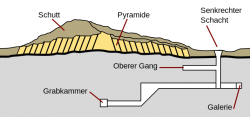


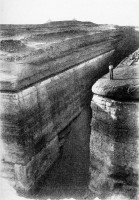
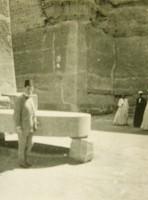
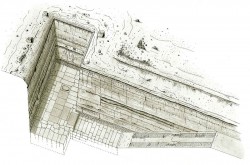
 By
By